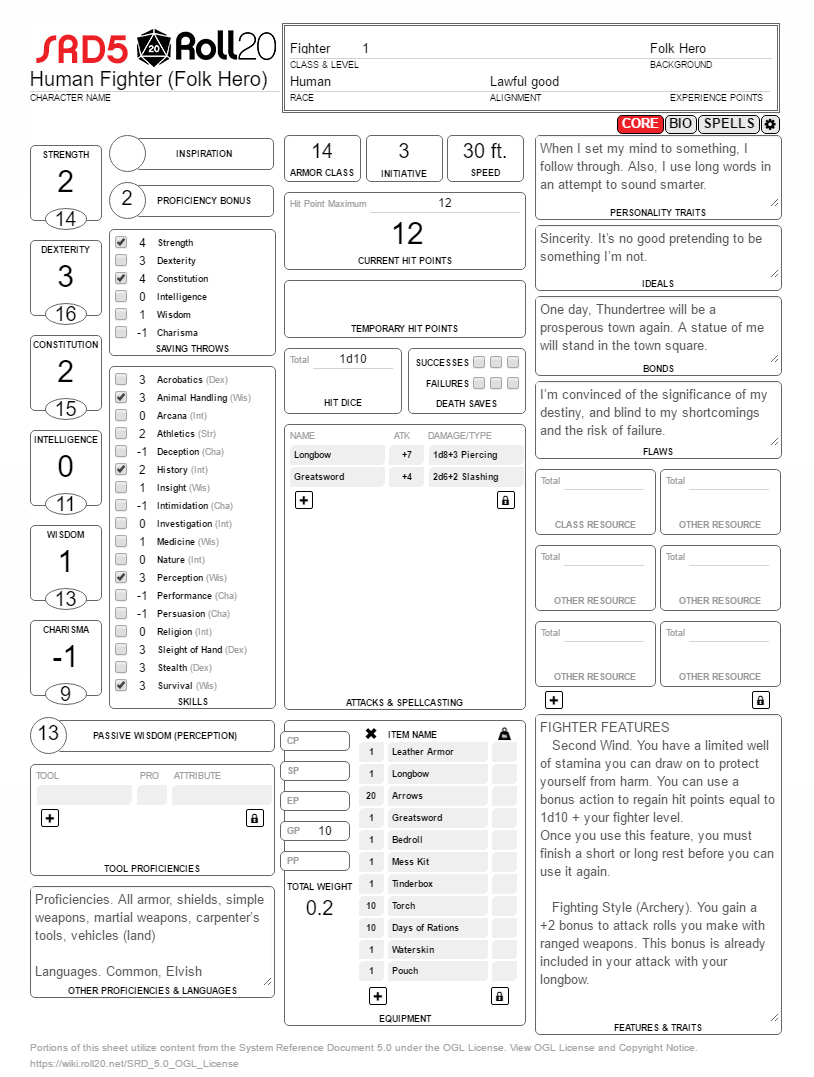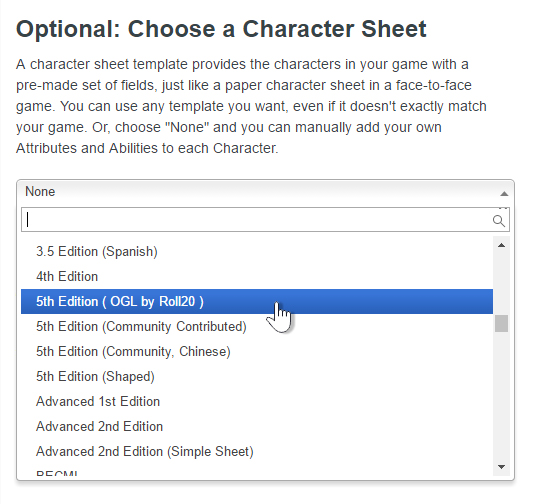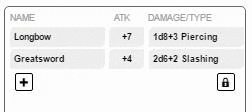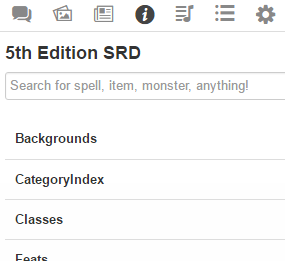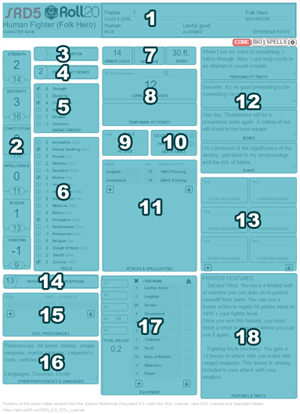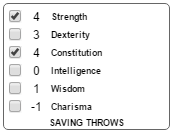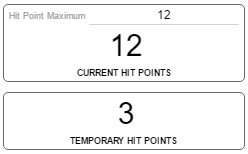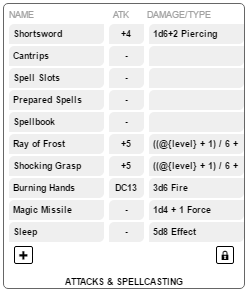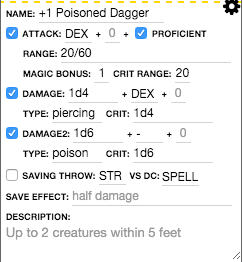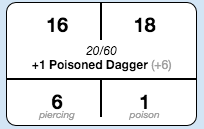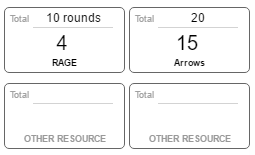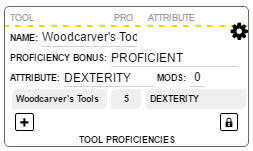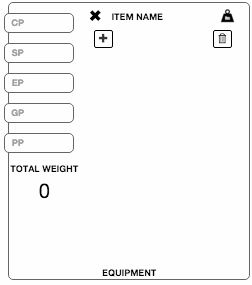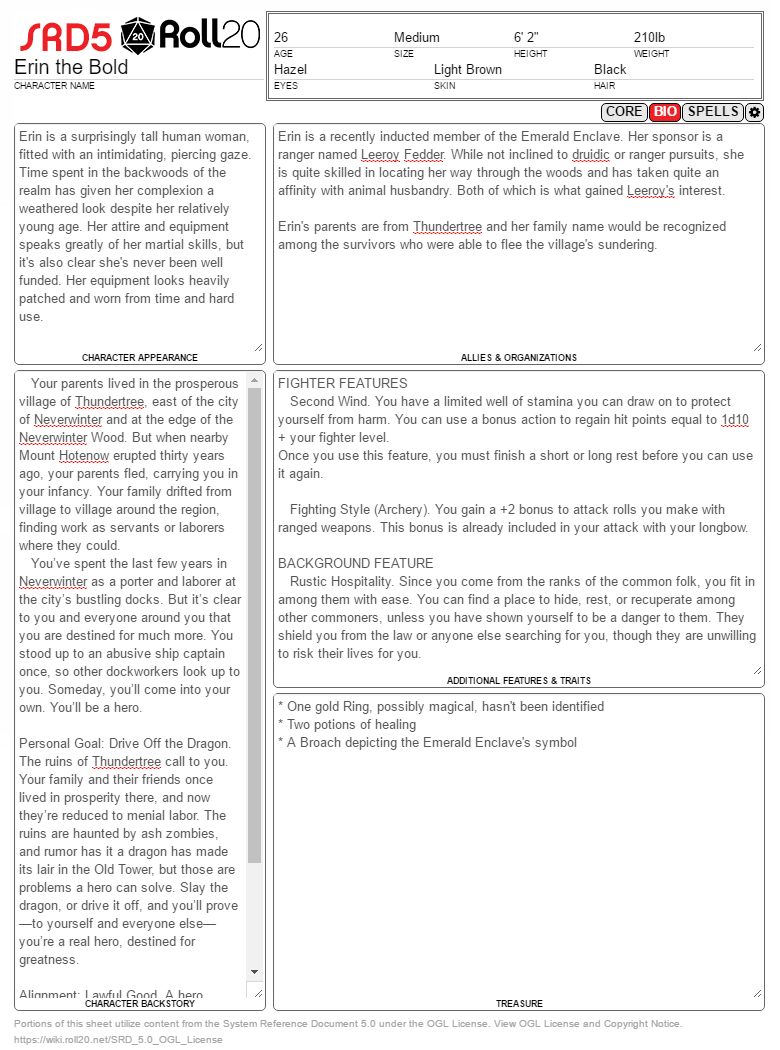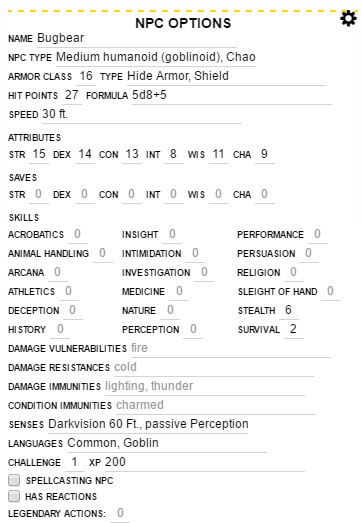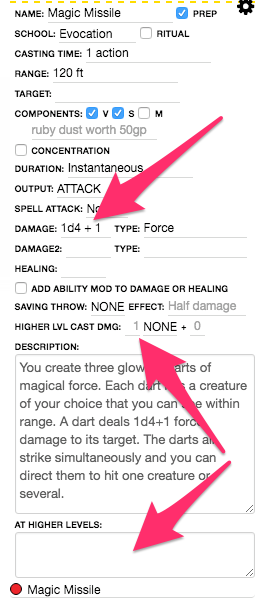Difference between revisions of "5th Edition OGL by Roll20"
From Roll20 Wiki
(→Transition Options) |
m (→Transition Options) |
||
| Line 345: | Line 345: | ||
===Transition Options=== | ===Transition Options=== | ||
| − | If your campaign previously used the [https://wiki.roll20.net/DnD5e_Character_Sheet#Intro Community Contributed] or [https:// | + | If your campaign previously used the [https://wiki.roll20.net/DnD5e_Character_Sheet#Intro Community Contributed] or [https://wiki.roll20.net/index.php?title=DnD5e_Shaped_Character_Sheet&oldid=11112#Author.28s.29 Shaped Legacy] 5th Edition Character Sheets and you are swapping over to this one, we have an automated conversion tool that will clear or merge elements left over from those two sheets. This procedure can only be done ''once'' and can not be undone. It is recommended that you make a copy of your campaign first before attempting a sheet transition. |
There is also a checkbox that hides this feature entirely from the sheet. If you hide this by mistake, you can gain access to it again by creating a new character journal. | There is also a checkbox that hides this feature entirely from the sheet. If you hide this by mistake, you can gain access to it again by creating a new character journal. | ||
Revision as of 16:04, 24 March 2017
Welcome to the 5th Edition OGL Character Sheet by Roll20!
The Basics
The Roll20 team is proud to bring you this cutting edge Roll20 official 5th Edition character sheet. The sheet was primarily authored by Roll20 developer Steve K.. Most sheet questions can be answered by the friendly folk of the Character Sheet forum. For questions, comments, or concerns with the 5th Edition sheet you can also contact Steve K. through Roll20 or at steve@roll20.net. All other questions can be directed to team@roll20.net.
Adding the Character Sheet to a Campaign
An official or community contributed character sheet can be added to any campaign when you first create it. On the Campaign Creation screen, underneath the large blue “I’m Ready, Create Game!” button, is the “Optional: Choose a Character Sheet” section. Located here is a drop down menu that lists all the character sheets built either by Roll20 officially or created by the community. These sheets are sorted under their respective RPG Systems in alphanumerical order. Once selected, a preview of the character sheet will load upon the creation page for you to review as well as showcase relevant information about the sheet, such as the sheet’s creator and its key features.
The Roll20 5th Edition OGL Sheet can be found under: Dungeons and Dragons → 5th Edition ( OGL by Roll20)
If you want to add a character sheet to an existing campaign, you can find this drop down menu once again by accessing the Campaign Settings Page from the Campaign Details Page.
| NOTE: If you have added custom attributes to your character journals prior to adding a character sheet to a campaign, you may want to delete them first. Adding a character sheet to a campaign will create its own set of custom attributes on all of your character journals, but it will reuse any attributes encountered if they share the same name. This can cause calculation issues on the sheet. |
If you were using either the 5th Edition Community Contributed or 5th Edition Shaped Sheets and wish to transfer over to the 5th Edition Roll20 version, there is method to smoothly transition between the two with a single click in the Roll20 Sheet's Transition Options.
Where to Find the Sheet
Once a character sheet has been added to a campaign, and once inside it,a new tab will be available on a character journal between the “Bio & Info” and “Attributes & Abilities” tab labeled “Character Sheet”. Much like the Attributes & Abilities tab, only players who have been granted Edit permissions for the journal entry will be able to access the Character Sheet tab.
Sheet Features
The 5th Edition sheet has all of the functionality of a pen and paper character sheet and much more. Certain aspects of the sheet have been streamlined or automated to remove bookkeeping and speed up gameplay. The key features are auto-calculations, macro buttons, and roll templates. The sheet defaults to using the rules as printed in the 5th Edition SRD, however it's dynamic enough to allow you and your group to use whatever custom house rules you require.
Auto Calculations
Many parts of the sheet use auto calculations to fill in derived attributes with the expectation that you're using the rules as printed in the 5th Edition SRD. Many of these calculated traits can be modified from the settings menu and those set by Sheet Workers can be edited directly. Below are some examples of Sheet Worker and Auto Calculation functionality:
- Class - Changing the character's class from the header will automatically update the character's saving throw proficiencies, their hit die type, spell casting ability, and spell save DC.
- Level - Changing the character's level will also update their proficiency bonus, number of spells per day, and more.
- Attributes - Changing one of the character's attributes will also update the related modifier, skills that are based on that attribute, and derived stats such as initiative or passive perception.
Roll Buttons and Roll Templates
Most of the stats in the game can be rolled by hovering over their name, the stat will turn red, and then left-clicking the mouse. This is true for Attributes, Saves, Skills, Hit Dice, Death Saves, Tool Proficiencies, Attacks & Spellcasting, Spell Cards, and NPC Actions. Any of these roll buttons can be dragged directly from the sheet to your Macro Quick Bar, enabled from the settings tab.
Player characters have both a simple and attack roll template that is output to the Chat Tab in the journal on the right hand side of the screen. The simple template is used for everything except for attacks. The attack template is shaped to show up to three pieces; the attack at the top, information in the middle, and damage at the bottom. Depending on your settings, the damage will not roll unless you click on the name of the attack from the roll template in the chat tab. This was designed to simulate the tabletop experience of rolling to attack and then rolling damage if necessary. You can change this behavior in the sheet Settings (gear icon at the top right of the page), tab under "Auto Damage Roll".
Rolling for Advantage and Disadvantage
With the Roll20 5th Edition OGL Sheet, Advantage is always rolled for convenience purposes. It is commonly agreed upon that a gaming group uses the left roll result when advantage is not being used for a check. When advantage or disadvantage is in play, simply choose the higher or lower result among the two per usual.
Resizable Text Fields
There are many free-text fields on the sheet that give you a place to keep information that doesn't necessarily follow a specific format. Some examples are the Personality Traits, Ideals, Bonds, Flaws, and Features & Trait sections. If your text overflows past the bottom of a text field, you can resize it to view the content in its entirety by clicking and dragging the bottom right corner icon shown in the adjoining image.
At present, these fields can only contain raw text. There are no formatting options (bold, italic, etc.) available.
The Padlock Button and Organizing Elements
There is a padlock icon set at the bottom of several different fields of the Roll20 5th Edition OGL Sheet. It is used where a player is meant to add entries such as individual attacks, actions, pieces of equipment, and spells. This icon behaves as a toggle button.
When set in the locked position (default), a player can add new entries into the field. When the button is toggled to unlocked, a player can no longer add new entries, but they will be able to delete any of the existing ones. The red trash bin icon overlaid on the right hand side of the entry will delete it. NOTE: This cannot be undone! On left side of every entry while the padlock is unlocked is a resort icon symbolized by three parallel lines. By clicking and dragging on this icon, you can rearrange the order of the entries in the field.
Utilizing the 5th Edition SRD Compendium
Upon adding the Roll20 5th Edition OGL Character Sheet to a campaign, the [5th Edition SRD Compendium] is automatically enabled for use as its own tab in the Sidebar of the application. It's located between the Journal and Jukebox tabs and is accessible for both GM and Player alike.
The Compendium allows for rapid searching of all rules, classes, monsters, spells, items, and more that are included in the 5th Edition SRD. This minimizes time spent for the gaming group to leaf through a book in the middle of a session for a rule clarification. Even better, both the GM and the Player can utilize dragging and dropping* from the Compendium tab directly to your character sheets. This makes statting NPCs and PCs far faster than inputing everything manually.
| NOTE: The 5th Edition SRD is similar but NOT identical to the Dungeons and Dragons 5th Edition Rule Book. Some skills, classes, creatures, items, and other elements found within the Dungeons and Dragons rule book are strictly intellectual property of Wizards of the Coast and not accessible through their Open-Game License(OGL). |
- * At present, dragging Compendium entries do not work if the character journal is popped out onto its own browser window.
Statting PCs
Dragging from the Compendium works for the Equipment and Spell fields of the PC Sheet. This will not only carry over the name of the item or spell, but the relevant attack and damage rolls and any rules or flavor text that comes with it. Adding Compendium items in this fashion also automatically adds the equipment item (if it's a weapon) or spell to the Attacks & Spellcasting field to roll directly from.
To insert a Compendium item into the character sheet, first you must create a new entry in either the Equipment field or Spell Page by clicking on the button with the plus symbol. The entry can be either complete collapsed or open for input for this to work. Next, run a search for the Item or Spell you want to add in the Compendium tab. Once found, click and drag on the Compendium item's name so that it creates a little named tile that follows along with your mouse. Drag this over to the empty entry you created on the character sheet. This entry will take on a yellow fill if this is done correctly. Let go of the tile and the entry will be auto-completed with all the data pertaining to the the Compendium entry. You can see this in action below under Equipment.
Statting NPCs
You can fill out an entire NPC sheet in a single drag and drop. Create a new character journal and enable the NPC Sheet on the Character Sheet tab. This will open the stat block so that it can be filled in manually. Keep this open and run a search for the NPC you want to create from the Compendium tab. Once found, click and drag on the NPC name so that it creates a little named tile that follows along with your mouse. Drag this over to the empty stat block on the character sheet. This entire field will take on a yellow fill if this is done correctly. Let go of the tile and the sheet will be filled with the entire NPC entry from the Compendium including their Actions, Reactions, and Legendary Actions if applicable.
One thing to note about dragging a stat block over from the Compendium is that it uses an additive behavior. It will not replace anything that you have already entered manually.
The PC Sheet
The Roll20 5th Edition OGL Sheet contains both the PC Sheet and the NPC Sheet. At default, a new character journal is set to the PC sheet, but you can switch between the two by toggling it from the General Options Settings. The PC Sheet is split up into four pages and can be selected from the buttons just underneath the header at the top of the sheet. They are listed from left to right order: The Core Page, The Bio Page, The Spells Page, and The Settings Page.
The Core Page
The Core Page is selected by default and has most of the information you'll want to use on a regular basis to play your character. This should look very similar to the content you would normally find on the first sheet of the physical 5th Edition OGL player character sheet. The screenshot at the top of this wiki page displays the entirety of the Core Page.(1) Core Header
The header block at the top of the sheet changes based on the page you have selected. On the Core page you can select a class by its dropdown menu. The available options from the dropdown are: Barbarian, Bard, Cleric, Druid, Fighter, Monk, Paladin, Ranger, Rogue, Sorcerer, Warlock, and Wizard. You can create a custom class from the Settings Page.
Once a class has been selected you can update the class's level by changing the number next to the class. The sheet will also automatically mark the abilities that class has proficiency in as well as automatically select the dice that will be used when Hit Dice are rolled. You can change the Hit Dice setting manually from the options menu. If your character multi-classes, then the secondary class and its level will appear beside the primary class. This Class and Level field can hold up to four classes if desired.
The fields for Background, Race, Alignment, and Experience Points allow you to fill in whatever text you wish to put in them. The Character Name persists over all pages of the sheet and is tied to the name you give to the journal entry. Changing it on the sheet itself will also change the name on the character journal and vice versa once it is closed.
(2) Attributes
Along the left side of the sheet are listed the 6 primary attributes: Strength, Dexterity, Constitution, Intelligence, Wisdom, and Charisma. These attributes are used by almost every other calculation on the sheet, as they are the core definition of a character. Each attribute block has the core attribute score, which can be changed by modifying the number in the oval at the bottom of each block, and, inside the square, the attribute modifier which is auto-calculated based on the score below it. The attribute modifier uses the following calculation to set the value:
[[floor((@{strength}-10)/2)]]
The attribute can be referenced by it's name, such as @{dexterity} while the attributes modifier can be referenced by adding the mod suffix, @{dexterity_mod}.
(3) Inspiration
You can track whether or not you have Inspiration by clicking the circle next to the Inspiration block at the top left of the Core page. This will toggle a dragon spiral icon on and off for indication purposes.(4) Proficiency Bonus
Your character's proficiency bonus is listed near the top left of the page. You cannot modify this value manually, instead it is automatically set based off your character's over-all level. You character's Level can be set by changing the number next to your Class name in the Header at the top when on the Core page.(5) Saving Throws
Next to the core Attributes on the left side of the page is a list of the same attributes to be used in making saving throws. To mark an attribute that your character has proficiency in for saving throws, check the box next to the appropriate attributes. When you select a class in the header section of the Core page it will automatically check the correct boxes for that class's proficiencies.(6) Skills
To the right of the Core Attributes is a list of all of the character's Skills. Each skill can be rolled by clicking on the skill name. If you have proficiency in a specific skill, then you would check the box next to the skill name, this will automatically add your proficiency bonus to that skill's checks. Each skill also lists the core attribute, that is used in the roll calculations, next to it in parenthesis.
You can set advanced skill options for the Settings page, such as skill expertise, flat bonuses from class archetypes or feats, as well as Jack of All Trades.
(7) Armor Class, Initiative, & Speed
The Armor Class & Speed blocks at the top center of the page can be used to keep track of your Armor and Speed values. The Initiative block cannot be modified manually, but instead is auto-calculated based off your character's Dexterity. If you have any additional initiative modifiers you can add them on the Settings (gear icon) tab under Initiative Modifier in the Class Options block.Armor Class can also be tracked automatically by using the Compendium compatible inventory, on by default.
Rolling for Initiative and the Turn Order Tracker
Clicking on the word INITIATIVE will roll that character's initiative score. If your players have tokens linked to their character sheets, they can roll their initiative and simultaneously add their character and its initiative score to the Turn Order Tracker automatically. What is required of the player is that their linked token must be currently selected on the Tabletop before they roll off their sheet.
(8) Hit Points & Temporary Hit Points
The Current Hit Points and Temporary Hit Points blocks are used to keep track of your character's Hit Points (HP). Inside the Current Hit Points block, at the top, is a line that lists the character's maximum amount of HP.
When your character takes damage, if they have any, it should be subtracted from their Temporary Hit Points first, then any remaining damage would then come off of the character's Current Hit Points.
(9) Hit Dice
The Hit Dice block is used to keep track of and roll your character's hit dice. Inside the Hit Dice block, at the top, is a line to keep track of the total number of dice your character can have. In the main area of the block you would keep track of the remaining hit dice. Clicking the "HIT DICE" label will roll the hit dice for your selected class automatically. If you wish to change the dice that is rolled you can do so in the Class Options section of the Settings Page (gear icon).
If your character is multi-classed, when rolling your hit dice, a pop-up will ask which of your character's current class's hit dice you want to roll. The total and current hit dice fields are just text fields, so you can use them to track totals for any number of multi-class configurations. Say, if your character is a Fighter/Cleric you can put "F 2 | C 1" in the field to track that you have 2 Fighter and 1 Cleric hit dice available.
(10) Death Saves
The Death Saves block is used to keep track of your character's death save rolls once they have been knocked out. You can click the "DEATH SAVES" label to make a death save roll. If you roll greater than 10 you would check one of the boxes next to "Successes" otherwise you would check a box next to "Failures". If your character has any modifiers to their death save rolls they can be added in the Class Options section of the Settings Page(gear icon).(11) Attacks & Spellcasting
The Attacks & Spellcasting block in the center of the Core page of this character sheet will be one of the most often used sections. To start, you can manually add any attack or spell to this section by hovering over the block and clicking the "Add" button(the + symbol). This will open a form that can be filled out with all of the information about the specific attack or spell you are adding.
This section will automatically add attacks, with all the stats, for spells that have an attack component when they are added to your spell sheet on the Spells Page. This happen both if you add the spell manually or if you drag and drop a spell from the Compendium. An attack is also automatically created if you drag and drop an item from the Compendium into your Equipment block (you must drop the Compendium item into the Equipment block, not the Attacks Spellcasting block). In both cases of copying from the Compendium you must add a new entry first and then drag the Compendium item onto the newly created entry. You can drag Compendium data onto any existing entry, so be careful not to drag it onto a entry that already has data or it will overwrite any information you have previously entered.
Since this is a dagger, and daggers have the "Finesse" attribute I can chose either STR or DEX for my bonus attribute. Erin is quicker than she is strong, so we will pick DEX as the attribute to attack with, as well as checking the "proficient" checkbox since Erin is experienced with using these sorts of weapons. She doesn't have any other gear that might make her attacks better, so we will leave the generic bonus between the attribute and proficiency blank, or 0. Being a +1 Poisoned Dagger means that it is also magical, so it gets a 1 in the magic bonus slot just below. A dagger can also be used as a thrown weapon, so we've added the weapon's throwing range info to the "Range" field. Since a weapon does damage, we have checked the first "Damage" checkbox and filled in the required fields. This dagger does 1d4 piercing damage + Erin's DEX mod + 0 bonus damage (this would be used for bonus damage on top of the magical +1) and it doesn't have anything to change the critical damage so we just put the same damage into the "crit" box. Because this dagger can also cause poison damage, we also check the second "Damage" checkbox and fill in the info for the 2nd set of damage. The poison does a flat 1d6 poison with no extra bonuses, so we've selected "-" to say there is no attribute that adds to this damage. This damage also doesn't have anything to make the crit different so we set that to 1d6 as well. There are no extra saving throws or effects that are included with this attack, so we leave these additional sections blank.
These additional effect sections will be used more commonly with spells, like Fireball, where you would require a DEX save against your SPELL DC, which will be set according to your character's spell casting level. For a fireball, the save effect would be "half damage" and the "Description" would be something like "Hits all creatures within 20 ft of the explosion point".
After you are done modifying all of individual stats for an attack you can click the gear icon at the top right of that section and it will hide the stats for that attack. If ever you need to change these stats in the future you can hover over the entry and click the gear icon that shows up to unhide the stats section.
Rolling from the Attacks & Spellcasting Block
Rolling from the Attacks & Spellcasting Block is no different than rolling from any other portions of the character sheet. Hovering your mouse over any entry here will highlight its entire label (NAME, ATK, and DAMAGE/TYPE) in red and you'll be able to click on it to roll the attack or spell. You can also drag this entry into the Macro Bar to give yourself easy access to this attack. Because this is a repeating section, the macro name will be a bit messy, but you can right-click the button and rename the macro to whatever you like.With any attack that checks for AC, you will see TWO rolls set side by side for the Armor Class check with the name of the attack listed underneath them with the Attack modifier bonus (ATK) appended to the Attack name in light grey. The Roll20 5th Edition OGL Character Sheet always rolls for Advantage, so you will always have two roll results for this check (most gaming groups use the left roll result if neither Advantage or Disadvantage is being factored in the check). If there is a specified range for the attack, this will be listed above the attack's name.
Underneath the AC Check and Attack Name is the Damage roll result for the attack. Underneath this roll result will be the Damage Type (ex. slashing, piercing, poison, fire, etc.) listed in light grey italicized font.
For spells that don't check for AC and instead require a Saving Throws to mitigate or negate the spell's effect, the SPELL DC is listed first. Underneath this, in italicized font, is the effect if a character succeeds the check listed. Underneath the effect is the required attribute saving throw that must be rolled. If Damage is applied, this result is rolled and listed next with its Damage Type.
| NOTE: If your character sheet's Settings have "Auto Damage Roll" set to "Don't Auto Roll Damage" under General Options, the damage will not be listed underneath the AC roll result in chat. The damage was rolled, but presently hidden from view. Anyone can see the damage delivered by manually unfolding the roll result open by hovering your mouse over the roll result in chat and clicking on the attack/spell's name. |
(12) Personality Traits, Ideals, Bonds, and Flaws
These are all resizable free-text fields to enter whatever you wish in here. There presently isn't a means to format the raw text (italicize, bold, font alignment, etc).
(13) Class & Other Resources
The Class & Other Resources blocks can be used to keep track of either an item quantity you have in your equipment (like arrows in a quiver), or skills that don't fit into the other sections on the sheet, like a Sorcerer's Sorcery Points, a Cleric's Channel Divinity at higher levels, or the number of rounds a Barbarian has been Raging so far in a combat encounter. There are three fields: Class Resource Max, Class Resource, and the Class Resource Name. The Class Resource Max field is a text box which allows you to quantify exactly what you're tracking (ex. "Total: 10 Rounds"). The Class Resource field is a numeral that you dial up or down or input directly. The Class Resource Name is a text box that allows you to label the resource when you click on the light grey "OTHER RESOURCE" label to overwrite it with your own ("OTHER RESOURCE" is placeholder text).
A resource block will be filled automatically if you checkmark an Equipment item as "USE AS A RESOURCE" and the Item Quantity field will be paired with the Class Resource field in the Resource block and vice versa (you'll need to click outside of the field or hit Enter for changes to refresh across the sheet). If the two resource blocks given by default are not enough then you can add additional blocks by hovering over the section and clicking the "Add" (+ symbol) button.
To call the first set of class resources use:
- Class Resource
@{class_resource} - Other Resource
@{other_resource}
To call the Repeating resources use
- Repeating Resource 1st left
@{repeating_resource_$0_resource_left} - Repeating Resource 1st right
@{repeating_resource_$0_resource_right} - Repeating Resource 2nd left
@{repeating_resource_$1_resource_left} - Repeating Resource 2nd right
@{repeating_resource_$1_resource_right} - ect.
(14) Tool Proficiencies
The Tool Proficiencies block is for listing a character's Tool Proficiency skills. At the bottom of this block is an "Add" (+ symbol) button. Clicking this will add a new entry to this block where you can add all of the relative stats for a specific tool proficiency, say Woodcarver's Tools. You can set the level of proficiency to either Proficient, Expertise, or Jack of All Trades. The roll bonus for that tool will reflect the proficiency level selected. Next is an Attribute drop down menu where you can select which character attribute to roll with for a proficiency check. The attribute used for the check will be up to the GM when it is time to make the roll check. If there is any additional bonus modifiers that come along with the tool in question, you can input it in the "MODS:" field.| NOTE: These fields are NOT currently Compendium Compatible for drag and drop. |
Once you finished filling out the stats for this tool you can click the gear icon at the top right of the entry to hide the stat fields and leaving behind just the rollable button. You can roll by either clicking on this rollable button or dragging it to your Macro Bar.
You can also use this section to create custom skills or rolls for your campaign setting or home-brew ruleset. Check out the Advanced Use section for further details.
(15) Other Proficiencies & Languages
This is a resizable free-text fields to enter whatever you wish in here. If you don't feel the Tool Proficiency block is needed (as in, you don't feel like your party will ever have to roll individual tool sets), you can store a character's Tool Proficiencies here instead. There presently isn't a means to format the raw text (italicize, bold, font alignment, etc).
(16) Equipment
The Equipment block at the bottom of the page has 2 different versions, a free text or a more rigid "rowed" version. The Simple version is a single plain text field where you can track all of your equipment in any format you wish. The Compendium Compatible version allows you to drag and drop items from the Compendium into the Equipment Block.
To swap between the two different Equipment block versions, first, go to the sheet's Settings Page (gear icon at the top right of the page) and then to the "General Options" section. Here, on the field labeled "Inventory", you can select between "Simple" or "Compendium Compatible" respectively. Like the name implies, if you want to be able to copy items directly from the Compendium using drag and drop, you must use the Compendium Compatible version. To quickly add an item from the Compendium, create a new equipment entry and then drag the item from the Compendium tab on the Sidebar and drop it on to the new Equipment entry. If the Compendium item is also a weapon, this method will add an attack in the Attacks and Spellcasting section.
You can also add items manually by hovering over the block and clicking the "Add" button (+ symbol). Each equipment entry, by default, show fields for quantity, name, and weight of an item. If you hover over a row and click the small "information" icon (grey-filled circle with a lowercase i centered in it) that appears at the bottom right of the entry you can also set some additional features.
- Equipped Checkbox: The checkbox changes the appearance of the Item Name so it's easier to tell what your character currently has equipped from a glance. When left unchecked, the Item Name's font turns grey. When checked, the Item Name becomes a solid black.
- Use As A Resource Checkbox: When checked, this will enable one of the Class Resource blocks and list the item name and its quantity within it. The quantity is tied between the two so changing it in one will be reflected in the other field after clicking outside the field.
- PROP: This is a text field where you would take note of weapon properties such as finesse, versatile, or light.
- MODS: This is a text field where you would take note if an item (likely magical) would modify your stats in some fashion.
- Available mods are
ac +N,saving throws +Nandspell attack +N; where N is a number between 1 and 9.
- Available mods are
- Description Field: This is a simple text field to include a description of the particular item and of any special qualities or effects it might have on the player.
Some if not all of these fields will be filled in automatically when adding from the Compendium (where applicable).
Both versions of the equipment field have the sections for each of the coins you may find on your adventures: copper(CP), silver(SP), electrum(EP), gold(GP), and platinum(PP). If you are following Encumbrance rules, the Compendium Compatible Equipment block will automatically calculate and track the weight of your character's backpack if you enter the weight values for any of the items in your Equipment list. When you character becomes encumbered, and depending on its severity, the words ENCUMBERED, HEAVILY ENCUMBERED, or IMMOBILE will display in red underneath the TOTAL WEIGHT value. You can also choose to not follow Encumbrance rules at all by toggling it off on the Settings Page.
(17) Features & Traits
This is a large resizable free-text field to enter whatever you wish in here. The Features and Traits block is a great place to store special notes about your character or of a certain piece of equipment or ability. There presently isn't a means to format the raw text (italicize, bold, font alignment, etc).
Bio Page
The Bio page, opened by selecting "BIO" from the 4 buttons near the top right of the sheet, is comprised of free-form text fields that can be used to keep track of less "structured" information about your character. You can use this page to describe your character's appearance, keep track of who their allies are and what organizations they've worked for, and on this page is a section to supplement the inventory list, on the front page, with the "Treasure" section, where you can keep track of all the loot you find along your travels.Bio Header
The header of the Bio page contains the basic run down of a character's physical appearance.
- Character Name: This is carried over from every single PC Page and matches the character journal's name
- Age: The character's current age
- Size: The size classification for the race type (Medium for most cases)
- Height: The character's height
- Weight: The character's weight
- Eyes: The character's eye color
- Skin: The character's skin color
- Hair: The character's hair color/style
Character Appearance
While the Bio Header describes the bare bone physical characteristics of a PC, this field is for fleshing out the visual peculiarities and/or cues of your character. Does you character have a piercing gaze? A stooped posture? Are they fancily dressed or are their clothes moth-eaten? In essence, this field is for everything and anything one would note about the character–from the equipment or garb they wear to how they comport themself.
Allies & Organization
This text field is for listing important or campaign relevant NPCs that the character may have a connection with. It's also for keeping track of faction allegiance. In the case of Dungeons & Dragons' Forgotten Realms world, a PC could be a member of the Harpers or the Emerald Enclave, among other major factions who are all vying for power of the continent.
Character Backstory
This field is for listing your character's pre-campaign history, their relations, and the pertinent places they have been to in the past.
Additional Features & Traits
This text field is a continuation of the Features & Traits section of the Core Page. The section on the Core Page is a good place for commonly utilized features of a character or briefly jotting down an abbreviated list. This field on the Bio page gives you more real estate to fully write down everything you need in whole.
Treasure
This text field is where you can list all the loot you've collected while searching bodies and delving through dungeons. Since much of these effects are transient and are likely to be used, given away, or sold to the highest bidder at the earliest opportunity, this may be preferable place to keep this list of items rather than adding them to the itemized Compendium Compatible Equipment section (if you have that version enabled).
Spell Page
Spell Page Header
 On the Spells page Header you can set the ability modifier that will be used for casting spells. Selecting the Spellcasting Ability block will allow you to select an attribute from a dropdown, and this will be used in all relevant spell rolls. This attribute will be set automatically when you select a spell casting class. The next two blocks, the Save DC and Attack Bonus will be set automatically based on the class that is selected on the Core page.
On the Spells page Header you can set the ability modifier that will be used for casting spells. Selecting the Spellcasting Ability block will allow you to select an attribute from a dropdown, and this will be used in all relevant spell rolls. This attribute will be set automatically when you select a spell casting class. The next two blocks, the Save DC and Attack Bonus will be set automatically based on the class that is selected on the Core page.
Spellcasting Ability
The Spellcasting Ability modifier will automatically update, depending on the class you select on the Core page, to the correct ability modifier for your class. If, for some reason, you need to change this value you can click on the modifier listed in this section and it will give you a drop-down list of all available ability modifiers.
Spell Save DC & Attack
The Spell Save DC and Spell Attack Bonus sections cannot be changed manually, but are just a visual output of modifiers that will be happening behind the scenes. The Spell Attack Bonus is the number that will be added to all spell attack rolls, automatically.
The Spell Save DC refers to the Save DC that enemies will have to beat when they are trying to dodge/resist your incoming spells. Say, Fred the Sorcerer casts Lightning bolt, and his Spell Save DC is 14. Any enemies hit by his attack will have to make a DEX save and try to beat 14. If they manage to beat the attack, then they are only grazed and take half of the damage. If they don't beat 14, then they take the full damage of the attack instead.
Spell Levels & Spells Per Day
The main section of the Spells page lists 10 sections, ranging from 0 (Cantrips) to 9, representing the Cantrips and spells level 1 - 9 where the level of the spell is listed in the triangle on the left of each section header. The number in the left square of the header represents the maximum number of times a spell of this level can be cast in between long rests. This number will be set automatically depending on the level of your character, but can be modified by clicking the up or down arrow or just entering a number in the space provided. The number in the right-most box in the headers can be used for you to keep track of the number of times you've cast a spell at this level, while resetting all of these numbers back to 0 every time your character takes a long rest.
Spell Roll Buttons
Selecting the "+" under any of the Spell Level headings will present you with a blank template where you can enter all of the information about a spell. By default, the spell card only contains non-attack information about a spell. If the spell IS an attack you can change the "Output" selector from "Spellcard" to "Attack", this will show some additional input to fill out the attack information about the spell. Switching this input will also add an attack to the "Attack" section on the "Core" page so this spell attack can also be cast from the main page. All of these sections are linked, so changing information in one place will also change the corresponding information in the other location.
With the new drag & drop compendium integration you can now add spells, with all of their information directly from the compendium. To add a spell, click the "+" under the level heading under which you wish to add the spell, look up the spell within the editor's compendium tab, then drag & drop the spell from the compendium tab onto the newly created, blank, spell slot. This will copy over all corresponding information linked to the spell, as well as creating an attack if relevant.
Settings Page
The Settings page, accessed by selecting the gear icon from the 4 buttons near the top right of the sheet, is where you can make changes to some parts of your character sheet that aren't represented on the other pages.
Class Options
In the class options section is where you have access to some important parts of your character, that usually are managed in the background. They are placed here so that, if needed they can be modified as well.
Hit Dice: This section will be set automatically depending on the class chosen on the Core page, but can be changed here by selecting the value and choosing a new one from the drop-down menu. This option is used whenever the "Hit Dice" section is used on the Core page.
Initiative Modifier: Usually, your initiative modifier is just based off of your DEX modifier, but if you happen to find a magical item that enhances these rolls this is where you will put that bonus. This modifier will be used whenever the "Initiative" section is rolled on the Core page.
Death Save Modifier: A normal death save is usually just a D20 against a dc of 10, but if you're lucky enough to have a bonus to death saves, this is where you will put your bonuses. This modifier will be represented any time a "Death Save" is rolled from the Core page.
Magic Caster Level: This number can be used to keep track of your "Magic Caster Level". It is not used in calculations anywhere on the sheet, it is just used to keep track of this bit of information. It's automatically updated when you change your character's level, and can be modified manually if the need arises.
Halfling Luck: Use this checkbox if your character is a Halfling that happens to take advantage of the Halfling Luck race feat. Using this feat will automatically re-roll any 1s rolled for attacks and skills or ability checks/saves.
Arcane Fighter/Rogue: These checkboxes can be used to keep track of when your fighter or rogue classed character actually has access to spells.
Multiclass Options
If you are taking advantage of the 5e multiclassing you can keep track of it in this section. Any levels to your character's additional classes must be changed here, and will then be reflected in the header portion of the sheet. Once you've added additional classes in this section, any time you roll Hit Dice from the Core page it will ask you which classes hit dice you wish to use.
Note: Be sure to not re-include your main class in this section, or your final level calculation will be incorrect.
Custom Class Options
If you are playing a class that is not part of the OGL SRD you can input the important class information in this section, and checking the "Use Custom Class" checkbox will replace the main class selection with your custom built class.
Skill Options
If your class offers the ability to achieve "Expertise" in a skill, or if you are using a Bard with the "Jack of All Trades" feat, this is where you will make these adjustments. There is also a section to add flat modifiers to any of your skills if your character has an archetype ability like Remarkable Athlete or a feat that adds a flat bonus to a skill. You can add expertise to any skill by clicking the value next to it and choosing "Expertise" from the drop-down menu. If your Bard has the Jack of All Trades feat, you can check the checkbox at the bottom of this section and it will automatically give half of your character's proficiency points to any skill check that doesn't have full proficiency.
General Options
The General Options section has some important options that deal more with how the sheet works, rather than actual character creation. Most importantly, the NPC checkbox at the top, which will change the sheet to be the NPC version which is shaped to more easily track an NPC's information.
Roll Queries - Always/Toggle/Query/Never Roll Advantage: This option will change how advantage is rolled for all attacks. It defaults to always roll advantage, which means that every time an attack is rolled it will roll twice and present the outcome of both rolls. This is useful for both advantage and disadvantage, otherwise you can just choose either the left or the right to be the default roll. Toggle adds a set of buttons to manually switch your advantage options between rolls. If Query is chosen, every time a roll is made it will ask you whether or not it's advantage. If Never is chosen, then it will always roll just a single dice per attack roll.
Whisper Rolls to GM: Like above, you have the option to Always/Query/Never whisper rolls to the GM. When this option is chosen the attack roll be only be whispered to the GM and not made public.
Auto Damage Roll: By default, damage rolls will not be rolled automatically, but only when you click the attack in the chat window. This is useful because you can choose to only roll damage when an attack hits. Using this option you can make the character always roll damage with every attack.
Inventory: With this option you can chose between the two versions of the inventory described in the Inventory section.
Transition Options
If your campaign previously used the Community Contributed or Shaped Legacy 5th Edition Character Sheets and you are swapping over to this one, we have an automated conversion tool that will clear or merge elements left over from those two sheets. This procedure can only be done once and can not be undone. It is recommended that you make a copy of your campaign first before attempting a sheet transition.
There is also a checkbox that hides this feature entirely from the sheet. If you hide this by mistake, you can gain access to it again by creating a new character journal.
The NPC Sheet
One of the most useful parts of the Roll20 5E OGL Character Sheet is that it contains both a PC sheet AND an NPC sheet. An NPC doesn't normally require the depth a PC sheet needs, so the NPC sheet is a much more slimmed down character sheet that doesn't require multiple pages like its PC counterpart. You can access this version of the sheet by going to the Settings Page, by clicking the gear icon near the top right of the sheet, and then checking the NPC checkbox. This will switch the sheet to the NPC version. You can switch back at any time by unchecking the NPC option under General Options on the new page.
NPC Options
This is the area where all of the NPC's stats will be entered, it covers everything from the NPC's name, to how strong or quick or smart it is, to what languages it speaks. Most of the fields in this section are just text fields used to keep track of information about the NPC. All of the information entered in these fields will be visible in the stat block once the NPC options are hidden.
Any text that appears in light grey is placeholder text. It's there to offer you an example of what the content would be for any given field.
By default no skill or ability checks will show up in the NPC's stat block. Once you've added a value to the corresponding skill or ability save, they will appear. If for some reason the NPC will have to make a check with a skill or ability it does not have any bonus in, you can enter a 0 as the modifier for that check and it will add it to the list in the stat block below.
The XP of an NPC auto-calculates based on its given challenge rating.
If the NPC is a spellcaster, you can check the checkbox beside SPELLCASTING NPC and this will add a spell list section that resembles a compact version of the PC's Spells Page.
At default, you can add Traits and Actions in their respective places after the Challenge Rating and XP area of the Stat Block. For Reactions and Legendary Actions, you need to enable them from the NPC Options section. For Reactions, check off the HAS REACTIONS checkbox. This will add a new sections to the Stat Block for you to add Reactions to. If an NPC is a monster with Legendary Actions then you must enter the number of actions that monster has access to each turn in the LEGENDARY ACTIONS: field. Once you add a number here, an additional section will appear in the stat block below, where you can add the specific legendary actions that the monster is able to do.
The NPC sheet supports Compendium drag & drop. If you want to add a new monster to your game just create a new character, switch it to NPC mode, then drag the monster from the Compendium tab of the Sidebar and drop it over the blank NPC Options section. This will automatically copy all of the information on that compendium page directly into the new sheet.
General Options
Within the NPC Options section, directly below the Legendary Actions field, is the General Options that are featured on the PC Sheet: NPC checkbox, WHISPER ROLLS TO GM, and the AUTO DAMAGE ROLL options. Unchecking the NPC checkbox from here will revert the sheet back to the PC Sheet.
Hiding NPC Options
Once all of the desired information has been entered, you can click the gear icon at the top right to hide this section. This leaves behind just the NPC's stat block where you can make all of your rolls from. You can re-open this section to edit the information at any time by clicking on the gear icon again. It's in the same location regardless if you're looking at NPC Options or the NPC stat block.
The NPC Stat Block
Any section of the stat block that has a corresponding roll will have click-able text. Say the NPC has to make a CON check, you can click the CON attribute to roll a CON check with all of the required modifiers automatically included. If you added a value to one of the skill modifier fields then that skill will show up in the NPC's "Saving Throws" list where you can click it to make a saving throw roll using that skill's modifier.
The first section of the Stat Block mirrors all the information you added in the NPC Options section. This content is meant exclusively for rolling and can not be edited directly. You will need to change them from the NPC Options section.
Traits
Traits are pieces of information about an NPC that isn't covered by the NPC options section. These are entered directly onto the NPC's stat block. If you click the "+" button that appears right below the "Senses/Languages/Challenge Rating" section it will add a blank entry where you can add a single trait for that NPC. Each Trait Entry features a bold title field which is then followed by a larger text box for the description of the trait. You can add any number of Traits for any NPC.
Actions
NPC actions can be used for any number of things. Each entry initially offers an Action Name field as well as a large text field for the Action description. The checkbox for ATTACK, once checked, adds more structured data fields needed for an attack roll (Type, Range/Reach, To Hit bonus, Target, Damage Roll, and Damage Type). To add a new entry you will select the "+" button that appears below the Actions section. Once all of this is complete you can click the gear icon at the top of this entry to hide the input fields, leaving just the action text. You can show this information, or roll the attack, in the chat box by clicking the text for the action. If you need to make further modifications to any action you can hover over the row you wish to edit, then click on the gear icon again. This will show all of the action information input fields again. You can add any number of Actions for any NPC.
Reactions
Once enabled from the NPC Options section, a new heading labeled "Reactions" and its relevant section is added to the stat block that allows you to add Reactions. These entries operate just like Traits.
Spells
Once enabled from the NPC Options section, a new heading labeled "Spells" and its relevant section is added to the stat block that allows you to add Spells. These entries will operate nearly identical to how Spells are added and handled on the PC Sheet with the one noted exception that there is only a single column of spell entries with no separation for spellcasting ranks.
Legendary Actions
If a number value is added to the LEGENDARY ACTIONS field in the NPC Options section, the Legendary Actions heading and section is added at the very bottom of the stat block and lists some verbiage on how many actions are available to be used on a given turn. This number is dictated by what you entered in the NPC Options. These entries operate the same way as Traits.
Rolling for Initiative for NPCs
Unlike the PC Sheet, there isn't a rollable button specifically labeled "Initiative" to roll for Initiative. In this case, you instead click on the NPC's Name to roll for Initiative. If you have the Turn Tracker tool open, having the NPC token selected while rolling Initiative will automatically add the NPC and its initiative roll to the tracker. Creatures on the GM layer that are added to the tracker in this fashion will have their entries hidden from the players.
You can also create a global Macro that will pop up as a Token Action button in the upper left hand corner of the tabletop every time a token is selected. This will allow you to roll without looking at the NPC sheet at all. The macro formula should look just like this:
%{selected|npc_init}
Advanced Use
Custom Skills and Stats
You can set up any number of custom skills or rolls from the Tool Proficiencies section just underneath the skill section on the Core tab. The Resources section is also useful for tracking custom stats to your campaign, game setting, or home-brew rules.
Dynamic References to Repeating Sections
A useful way for GMs and Players to reference their abilities is by dynamically setting up a handful of macros that can be used on a token linked to a character, rather than having to roll directly from the sheet. To do this, you'll set up a global macro from the main settings tab, from the chat pane, in the upper right hand corner of the application. The example we'll be using today is setting up the 1st NPC action:
%{selected|repeating_npcaction_$0_npc_action}
Now whenever you use this macro it will roll the first NPC action of whichever NPC token you have selected. You can set up a roll for each action by incrementing the 0 by 1 for each action you wish to add (I.E. $1, $2, $3). Here is a list of important repeating section rolls and their formulas:
- NPC Actions
%{selected|repeating_npcaction_$0_npc_action} - NPC Legendary Actions
%{selected|repeating_npcaction-l_$0_npc_action} - NPC Spells
%{selected|repeating_spell-npc_$0_spell} - Player Attack/Spell
%{selected|repeating_attack_$0_attack} - Tool/Custom Skill
%{selected|repeating_tool_$0_tool} - Spellbook Cantrip
%{selected|repeating_spell-cantrip_$0_spell} - Spellbook Level 1
%{selected|repeating_spell-1_$0_spell} - Spellbook Level 2
%{selected|repeating_spell-2_$0_spell} - Spellbook Level 3
%{selected|repeating_spell-3_$0_spell} - Spellbook Level 4
%{selected|repeating_spell-4_$0_spell} - Spellbook Level 5
%{selected|repeating_spell-5_$0_spell} - Spellbook Level 6
%{selected|repeating_spell-6_$0_spell} - Spellbook Level 7
%{selected|repeating_spell-7_$0_spell} - Spellbook Level 8
%{selected|repeating_spell-8_$0_spell} - Spellbook Level 9
%{selected|repeating_spell-9_$0_spell}
Directly Referencing Attributes
You can discover the name of most of the attributes in the sheet by hovering over them. After a couple of seconds a title will pop up and tell you how to referencing them. You can call attributes in a roll by adding a "@{name}" code. For example you could roll a 1d20 and add your strength modifier by rolling/r 1d20+@{strength_mod}. Here are a list of some of the more important stats:
strength
dexterity
constitution
intelligence
wisdom
charisma
strength_mod
dexterity_mod
constitution_mod
intelligence_mod
wisdom_mod
charisma_mod
strength_save_bonus
dexterity_save_bonus
constitution_save_bonus
intelligence_save_bonus
wisdom_save_bonus
charisma_save_bonus
acrobatics_bonus
animal_handling_bonus
arcana_bonus
deception_bonus
history_bonus
insight_bonus
intimidation_bonus
investigation_bonus
medicine_bonus
nature_bonus
perception_bonus
performance_bonus
persuasion_bonus
religion_bonus
sleight_of_hand_bonus
stealth_bonus
survival_bonus
pb
passive_wisdom
ac
initiative_bonus
speed
hp
hp_max
hp_temp
hit_dice
hit_dice_max
weighttotal
spell_save_dc
spell_attack_bonus
Custom AC Items
You can add pieces to your inventory and manually give them AC or magic bonuses that will figure into their calculations automatically. Inside the item options is a section for "MODS:". Add Ac +1 to add an armor class bonus.
Roll Templates
The 5th Edition OGL Character Sheet also includes a series of Roll Templates that you can use to dress up your own custom macros. Roll Templates provide additional layout and styling options for the display of roll results.
For a full list of available roll templates, see the 5e OGL Roll Templates wiki page.
Magic Missile Spell
The Roll20 Compendium entry for the Magic Missile spell uses the damage of 3d4+3 as its base. This damage output includes all three magic missiles generated at 1st level. This decision was made so that Magic Missile functions the same as all other spells, where you only have to roll the spell a single time to see the output of its damage, rather than three times (once for each missile). If you need to determine the order of damage per missile, you can hover over the damage output in the chat pane to see what each dice rolled and in what order. This is true for the damage output as well as Higher Casting damage.
If you would like the Magic Missile spell set up to roll only 1d4+1 per roll, you can set up a version of the Magic Missile spell that has a DAMAGE section of 1d4 + 1 and no HIGHER LVL CAST DMG or AT HIGHER LEVELS data.
Utilizing the 5th Edition OGL Companion API Script
In addition to the Roll20 5th Edition OGL Character Sheet, there is also the 5th Edition OGL Companion API Script. API Scripts allow for greater customization and functionality to how Roll20 operates beyond what it can do at default.
| Installing & creating API Scripts is a Roll20 PRO-only feature. In order to be able to access these advanced scripts, the GM of the campaign must be a PRO subscriber and enable it for their campaign. |
How to Add the API Script to your Game
If you have a PRO account, you can install the API script by going to your game's Campaign Page and clicking on the Settings button, and then choosing API Scripts. This brings you to the API Scripts page for your current game. The Companion Script is part of the One-Click Community API Installation options. Under the Script Library tab, there is a drop down menu that lists all the available community created scripts. Scroll down till you find the System Toolbox category and select the "5th Edition OGL by Roll20 Companion" script. The version number, the script's author, and a brief description of what the script does will appear right below the drop down menu once it is selected. Below that, click on the blue "Add Script" button to add the script to your game.
Automatic Ammunition Tracking
Automatic Ammunition Track is a feature that requires the above Companion API Script. Once installed, follow these instructions to enable automatic ammunition tracking in your game:
This example sets up a Longbow with a quiver of Arrows to track.
- On the Settings (Gear Icon) tab of a character sheet, under GENERAL OPTIONS, make sure that the INVENTORY option is set to "Compendium Compatible" and not "Simple".
- While still under GENERAL OPTIONS, set the AMMO TRACKING feature to ON.
- Add a blank item slot by clicking on the + icon in the Equipment section. Drag the missile weapon (Longbow) from the compendium onto the blank item section you just made.
- Add a blank item slot by clicking on the + icon in the Equipment section. Drag the missile type (Arrows) from the compendium onto the blank item section you just made.
- Expand the missile type (Arrows) by clicking on the "I" information icon that appears when hovering the mouse over the item.
- Select the USE AS RESOURCE checkbox.
- On the Settings (Gear Icon) tab under GENERAL OPTIONS select the AMMO TRACKING feature to ON.
- On the CORE tab, expand the missile weapon (Long Bow) in the ATTACKS & SPELLCASTING section by clicking on the gear icon that appears when hovering over the attack.
- In the AMMUNITION section put the exact name of the ammunition resource (Arrows)
Now, any time the missile weapon (Longbow) is rolled, a piece of ammunition will automatically be spent and the chat will make note. Additionally after the first time the missile weapon is used the AMMUNITION section will update with the ID of the resource repeating section, this is normal and expected.





